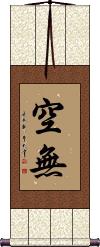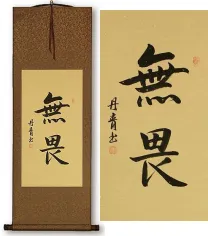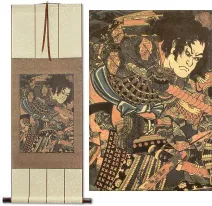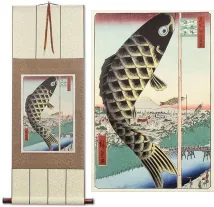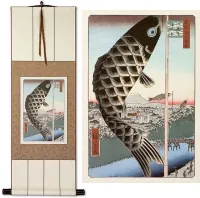Many custom options...
And formats...

Not what you want?
Try other similar-meaning words, fewer words, or just one word.
Feel free to email me with your request. If it's easy, I'll translate it for free and add it to this database of calligraphy for you.
No Illusion in Chinese / Japanese...
Buy a No Illusion calligraphy wall scroll here!
Personalize your custom “No Illusion” project by clicking the button next to your favorite “No Illusion” title below...
Flower in the Mirror, Moon on Water
鏡花水月 is an old Asian proverb that means “flowers in a mirror and the moon reflected in the lake” or “flowers reflected on a mirror and the moon reflected on the water's surface.”
Literally, 鏡花水月 reads “Mirror Flower, Water Moon.”
Figuratively this can be used to represent a lot of different ideas. It can be used to express an unrealistic rosy view or viewing things through rose-tinted spectacles. So you can use it to relay an idea about something that is visible but has no substance,
something that can be seen but not touched, or something beautiful but unattainable such as dreams or a mirage.
This expression is used to describe things like the subtle and profound beauty of poems that cannot be described in words.
鏡 = Mirror (or lens)
花 = Flower(s)
水 = Water
月 = Moon
Can also be written 水月鏡花 (just a slight change in word/character order).
Nothingness
空無 is “nothingness” in a Buddhist context.
The first character means empty but can also mean air or sky (air and sky have no form).
The second character means have not, no, none, not, or to lack.
Together these characters reinforce each other into a word that means “absolute nothingness.”
I know this is a term used in Buddhism, but I have not yet figured out the context in which it is used. I suppose it can be the fact that Buddhists believe that the world is a non-real illusion, or perhaps it's about visualizing yourself as “nothing” and therefore leaving behind your desire and worldliness.
Buddhist concepts and titles often have this element of ambiguity or, rather, “mystery.” Therefore, such ideas can have different meanings to different people, and that's okay. If you don't get it right in this lifetime, there will be plenty more lifetimes to master it (whatever “it” is, and if “it” really exists at all).
Soothill defines this as “Unreality, or immateriality, of things, which is defined as nothing existing of independent or self-contained nature.”
This in-stock artwork might be what you are looking for, and ships right away...
Gallery Price: $108.00
Your Price: $59.88
Gallery Price: $108.00
Your Price: $59.88
Gallery Price: $61.00
Your Price: $33.88
Gallery Price: $61.00
Your Price: $33.88
Gallery Price: $61.00
Your Price: $33.88
Gallery Price: $61.00
Your Price: $33.88
Gallery Price: $61.00
Your Price: $33.88
Gallery Price: $108.00
Your Price: $59.88
Gallery Price: $90.00
Your Price: $49.88
Not the results for no illusion that you were looking for?
Below are some entries from our dictionary that may match your no illusion search...
| Characters If shown, 2nd row is Simp. Chinese |
Pronunciation Romanization |
Simple Dictionary Definition |
明 see styles |
míng ming2 ming mei / me めい |
More info & calligraphy: Light / Bright(1) (ant: 暗) brightness; (2) discernment; insight; an eye (for); (3) (See 明を失う) eyesight; vision; (prefix) (4) (abbreviation) (See 明治) nth year in the Meiji era (1868.9.8-1912.7.30); (surname) Meishuu vidyā, knowledge. ming means bright, clear, enlightenment, intp. by 智慧 or 聰明 wisdom, wise; to understand. It represents Buddha-wisdom and its revelation; also the manifestation of a Buddha's light or effulgence; it is a term for 眞言 because the 'true word' can destroy the obscurity of illusion; the 'manifestation' of the power of the object of worship; it means also dhāraṇīs or mantras of mystic wisdom. Also, the Ming dynasty A. D. 1368-1644. |
迷 see styles |
mí mi2 mi mei |
More info & calligraphy: Lost / Dazed and Confusedmāyā; delude, deceive, confuse, mislead; delusion, illusion, etc. |
幻像 see styles |
genzou / genzo げんぞう |
More info & calligraphy: Illusion |
幻想 see styles |
huàn xiǎng huan4 xiang3 huan hsiang gensou / genso げんそう |
More info & calligraphy: Fantasy / Illusion(noun, transitive verb) fantasy; illusion; vision; dream |
無心 无心 see styles |
wú xīn wu2 xin1 wu hsin mushin むしん |
More info & calligraphy: No Mind / Mushin(adj-na,adj-no,n) (1) innocence; (adj-na,n,adj-no) (2) insentient (i.e. plants, inanimate objects, etc.); (adj-na,n,adj-no) (3) {Buddh} (See 有心) free from obstructive thoughts; (vs,vt) (4) to pester someone (for cash, etc.) Mindless, without thought, will, or purpose; the real immaterial mind free from illusion; unconsciousness, or effortless action. |
覺性 觉性 see styles |
jué xìng jue2 xing4 chüeh hsing kakushou / kakusho かくしょう |
More info & calligraphy: The Nature of Enlightenment in One's MindThe enlightened mind free from all illusion. The mind as the agent of knowledge, or enlightenment. Also used for dharmakāya, v. 三身; 三寶, etc. |
陽光 阳光 see styles |
yáng guāng yang2 guang1 yang kuang youkou / yoko ようこう |
More info & calligraphy: Sunshinesunshine; sunlight; (female given name) Yōkou The sun's light, also idem陽燄 sun flames, or heat, i.e. the mirage causing the illusion of lakes. |
垢 see styles |
gòu gou4 kou ku く |
dirt; disgrace {Buddh} (See 煩悩・2) klesha (polluting thoughts such as greed, hatred and delusion, which result in suffering); (personal name) Yoshimi mala. Dust, impurity, dregs; moral impurity; mental impurity. Whatever misleads or deludes the mind; illusion; defilement; the six forms are vexation, malevolence, hatred, flattery, wild talk, pride; the seven are desire, false views, doubt, presumption, arrogance, inertia, and meanness. |
幻 see styles |
huàn huan4 huan maboroshi まぼろし |
fantasy (noun - becomes adjective with の) (1) phantom; vision; illusion; apparition; (noun - becomes adjective with の) (2) something fleeting; short-lived dream; (noun - becomes adjective with の) (3) fabled item; mythical thing; very rare thing; (surname) Maboroshi māyā. Illusion, hallucination, a conjurer's trick, jugglery, i. e. one of the ten illustrations of unreality. |
惑 see styles |
huò huo4 huo waku わく |
to confuse; to be puzzled {Buddh} (See 煩悩・ぼんのう・2) klesha; (given name) Waku moha. Illusion, delusion, doubt, unbelief; it is also used for kleśa, passion, temptation, distress, care, trouble. |
我 see styles |
wǒ wo3 wo ga が |
I; me; my (1) {Buddh} obstinacy; (2) atman; the self; the ego I, my, mine; the ego, the master of the body, compared to the ruler of a country. Composed of the five skandhas and hence not a permanent entity. It is used for ātman, the self, personality. Buddhism takes as a fundamental dogma 無我, i.e. no 常我, no permanent ego, only recognizing a temporal or functional ego. The erroneous idea of a permanent self continued in reincarnation is the source of all illusion. But the Nirvana Sutra definitely asserts a permanent ego in the transcendental world, above the range of reincarnation; and the trend of Mahāyāna supports such permanence; v. 常我樂淨. |
獮 狝 see styles |
xiǎn xian3 hsien sen |
to hunt in autumn (archaic) markaṭa, 獮猴 a monkey, typical of the mind of illusion, pictured as trying to pluck the moon out of the water; also of the five desires; of foolishness; of restlessness. |
觀 观 see styles |
guàn guan4 kuan kan |
Taoist monastery; palace gate watchtower; platform vipaśyanā; vidarśanā. To look into, study, examine, contemplate; contemplation, insight; a study, a Taoist monastery; to consider illusion and discern illusion, or discern the seeming from the real; to contemplate and mentally enter into truth. 覺 is defined as awakening, or awareness, 觀 as examination or study. It is also an old tr. of the word Yoga; and cf. 禪 17. Guan is especially a doctrine of the Tiantai school as shown in the 止觀 q.v. |
三密 see styles |
sān mì san1 mi4 san mi sanmitsu さんみつ |
{Buddh} three mysteries (Buddha's body, speech and mind) The three mystic things: the body, mouth (i.e. voice), and mind of the Tathāgata, which are universal, all things being this mystic body, all sound this mystic voice, and all thought this mystic mind. All creatures in body, voice, and mind are only individualized parts of the Tathāgata, but illusion hides their Tathāgata nature from them. The esoterics seek to realize their Tathāgata nature by physical signs and postures, by voicing of 眞言 dhāraṇī and by meditations, so that 入我我入 He may enter me and I Him, which is the perfection of siddhi 悉地; v. 大日經疏 1. 菩提心論. |
三德 see styles |
sān dé san1 de2 san te santoku |
The three virtues or powers, of which three groups are given below. (1) (a) 法身德 The virtue or potency of the Buddha's eternal, spiritual body, the dharmakāya; (b) 般若德 of his prājñā, or wisdom, knowing all things in their reality; (c) 解脫德 of his freedom from all bonds and his sovereign Iiberty. Each of these has the four qualities of 常, 樂我, 淨eternity, joy, personality, and purity; v. 漫涅槃經 (2) (a) 智德 The potency of his perfect knowledge; (b) 斷德 of his cutting off all illusion and perfecting of supreme nirvāṇa; the above two are 自利 for his own advantage; (c) 恩德 of his universal grace and salvation, which 利他 bestows the benefits he has acquired on others. (3) (a) 因圓德 The perfection of his causative or karmic works during his three great kalpas of preparation; (b) 果圓德 the perfection of the fruit, or results in his own character and wisdom; (c) 恩圓德 the perfection of his grace in the salvation of others. |
三惑 see styles |
sān huò san1 huo4 san huo sanwaku; sannaku さんわく; さんなく |
{Buddh} three mental disturbances A Tiantai classification of the three delusions, also styled 三煩惱; 三漏; 三垢; 三結; trials or temptations, leakages, uncleannesses, and bonds. The first of the following three is common to all disciples, the two last to bodhisattvas. They arise from (a) 見, 思, 惑 things seen and thought, i.e. illusions from imperfect perception, with temptation to love, hate, etc.; to be rid of these false views and temptations is the discipline and nirvāṇa of ascetic or Hīnayāna Buddhists. Mahāyāna proceeds further in and by its bodhisattva aims, which produce their own difficulties, i.e. (b) 塵沙惑 illusion and temptation through the immense variety of duties in saving men; and (c) 無明惑 illusions and temptations that arise from failure philosophically to understand things in their reality. |
三輪 三轮 see styles |
sān lún san1 lun2 san lun sanrin さんりん |
three wheels; (p,s,f) Miwa The three wheels: (1) The Buddha's (a) 身 body or deeds; (b) 口 mouth, or discourse; (c) 意 mind or ideas. (2) (a) 神通 (or 變) His supernatural powers, or powers of (bodily) self-transformation, associated with 身 body; (b) 記心輪 his discriminating understanding of others, associated with 意 mind; (c) 敎誡輪 or 正敎輪 his (oral) powers of teaching, associated with 口. (3) Similarly (a) 神足輪 ; (b) 說法輪 ; (c) 憶念輪 . (4) 惑, 業, and 苦. The wheel of illusion produces karma, that of karma sets rolling that of suffering, which in turn sets rolling the wheel of illusion. (5) (a) Impermanence; (b) uncleanness; (c) suffering. Cf. 三道. |
三道 see styles |
sān dào san1 dao4 san tao mitsumichi みつみち |
(surname) Mitsumichi (1) The three paths all have to tread; 輪廻三道, 三輪, i.e. (a) 煩惱道 ; 惑道 ; the path of misery, illusion, mortality; (b) 業道 the path of works, action, or doing, productive of karma; (c) 苦道 the resultant path of suffering. As ever recurring they are called the three wheels. (2) 聾, 緣, 菩 śrāvakas, pratyekabuddhas, bodhisattvas, cf. 三乘. |
三達 三达 see styles |
sān dá san1 da2 san ta mitatsu みたつ |
(surname) Mitatsu Three aspects of the omniscience of Buddha: knowledge of future karma, of past karma, of present illusion and liberation; v. 三明. |
三餘 三余 see styles |
sān yú san1 yu2 san yü sanyo |
The three after death remainders, or continued mortal experiences, of śrāvakas and pratyekabuddhas, who mistakenly think they are going to 無餘涅槃final nirvāṇa, but will still find 煩惱餘 further passion and illusion, 業餘 further karma, and 果餘 continued rebirth, in realms beyond the 三界trailokya. |
二執 二执 see styles |
èr zhí er4 zhi2 erh chih nishū |
The two (erroneous) tenets, or attachments: (1) 我執 or 人執 that of the reality of the ego, permanent personality, the ātman, soul or self. (2) 法執 that of the reality of dharma, things or phenomena. Both are illusions. "All illusion arises from holding to the reality of the ego and of things." |
二心 see styles |
èr xīn er4 xin1 erh hsin nishin ふたごころ |
disloyalty; half-heartedness; duplicity duplicity; treachery; double-dealing The two minds, 眞心 the original, simple, pure, natural mind of all creatures, the Buddha-mind, i.e. 如來藏心; and 妄心 the illusion-mind, which results in complexity and confusion. Also, 定心 the meditative mind, or mind fixed on goodness; and the 散心 the scattered, inattentive mind, or mind that is only good at intervals. |
二惑 see styles |
èr huò er4 huo4 erh huo niwaku |
The two aspects of illusion: 見惑 perplexities or illusions and temptations arise from false views or theories. 思惑 or 修惑, ditto from thoughts arising through contact with the world, or by habit, such as desire, anger, infatuation, etc. They are also styled 理惑 illusions connected with principles and 事惑 illusions arising, in practice; v. 見思. |
五力 see styles |
wǔ lì wu3 li4 wu li goriki |
pañcabalāni, the five powers or faculties — one of the categories of the thirty-seven bodhipakṣika dharma 三十七助道品; they destroy the 五障 five obstacles, each by each, and are: 信力 śraddhābala, faith (destroying doubt); 精進力 vīryabala, zeal (destroying remissness); 念 or 勤念 smṛtibala, memory or thought (destroying falsity); 正定力 samādhibala, concentration of mind, or meditation (destroying confused or wandering thoughts); and 慧力 prajñābala, wisdom (destroying all illusion and delusion). Also the five transcendent powers, i. e. 定力 the power of meditation; 通力 the resulting supernatural powers; 借識力 adaptability, or powers of 'borrowing' or evolving any required organ of sense, or knowledge, i. e. by beings above the second dhyāna heavens; 大願力 the power of accomplishing a vow by a Buddha or bodhisattva; and 法威德力 the august power of Dharma. Also, the five kinds of Mara powers exerted on sight, 五大明王. |
五忍 see styles |
wǔ rěn wu3 ren3 wu jen gonin |
The five stages of bodhisattva-kṣānti, patience or endurance according to the 別教: (1) 伏忍the causes of passion and illusion controlled but not finally cut off, the condition of 十住, 十行, and 十廻向; (2) 信忍 firm belief, i. e. from the 初地 to the 三地; (3) 順忍 patient progress towards the end of all mortality, i. e. 四地 to 六地; (4) 無生忍 patience for full apprehension, of the truth of no rebirth, 七地 to 九地; and (5) 寂滅忍 the patience that leads to complete nirvana, 十地 to 妙覺; cf. 五位. |
五觀 五观 see styles |
wǔ guān wu3 guan1 wu kuan gokan |
The five meditations referred to in the Lotus Sutra 25: (1) 眞 on the true, idem 空觀, to meditate on the reality of the void or infinite, in order to be rid of illusion in views and thoughts; (2) 淸淨觀 on purity, to be rid of any remains of impurity connected with the temporal, idem 假觀; (3) 廣大智慧觀 on the wider and greater wisdom, idem 中觀, by study of the 'middle' way; (4) 悲觀 on pitifulness, or the pitiable condition of the living, and by the above three to meditate on their salvation; (5) 慈觀 on mercy and the extension of the first three meditations to the carrying of joy to all the living. |
五食 see styles |
wǔ shí wu3 shi2 wu shih gojiki |
The five kinds of spiritual food by which roots of goodness are nourished: correct thoughts; delight in the Law; pleasure in meditation; firm resolve, or vows of self-control; and deliverance from the karma of illusion. |
作佛 see styles |
zuò fó zuo4 fo2 tso fo sabutsu |
To become or be a Buddha; to cut off illusion, attain complete enlightenment, and end the stage of bodhisattva discipline. |
俗智 see styles |
sú zhì su2 zhi4 su chih zokuchi |
Common or worldly wisdom, which by its illusion blurs or colours the mind, blinding it to reality. |
修惑 see styles |
xiū huò xiu1 huo4 hsiu huo shuwaku しゅわく |
{Buddh} perceptive mental disturbances Illusion, such as desire, hate, etc., in practice or performance, i.e. in the process of attaining enlightenment; cf. 思惑. |
Click here for more no illusion results from our dictionary
The following table may be helpful for those studying Chinese or Japanese...
| Title | Characters | Romaji (Romanized Japanese) | Various forms of Romanized Chinese | |
| Flower in the Mirror, Moon on Water | 鏡花水月 镜花水月 | kyou ka sui getsu kyoukasuigetsu kyo ka sui getsu | jìng huā shuǐ yuè jing4 hua1 shui3 yue4 jing hua shui yue jinghuashuiyue | ching hua shui yüeh chinghuashuiyüeh |
| Nothingness | 空無 空无 | kuu mu / kuumu / ku mu | kōng wú / kong1 wu2 / kong wu / kongwu | k`ung wu / kungwu / kung wu |
| In some entries above you will see that characters have different versions above and below a line. In these cases, the characters above the line are Traditional Chinese, while the ones below are Simplified Chinese. | ||||
Successful Chinese Character and Japanese Kanji calligraphy searches within the last few hours...

